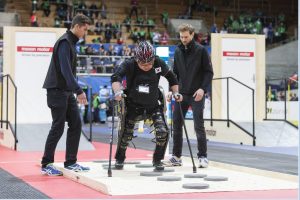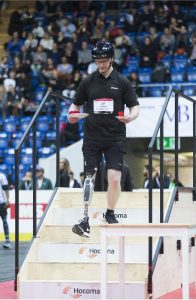This story actually dates from almost a year ago but I only just heard about it myself and since it relates directly with one of my previous posts (11Mar17) I hope you’ll still find it interesting.
In October of 2016 the first ever athletic competition for cyborgs, yes you heard me right cyborgs, was held in Zurich, Switzerland. The competition was conceived by Robert Riener of the Swiss Federal Institute of Technology as a way to promote the development of computerized assistive technologies for the physically disabled. The organizers of the event also did so in an effort to get engineers working with assistive technologies to interact more with their potential users in order to improve their designs.
The event consisted of six events ranging from paralyzed individuals using exo-skeleton suits to walk through obstacle courses to amputees grasping and using everyday objects with powered prosthetic limbs. There was also a ‘virtual marathon’ where tetraplegics, people with little or no use of any limb, used their brains only to control computerized avatars.
The exo-skeleton obstacle course was designed to replicate normal life with walking up ramps and stairs along with maneuvering around corners. In other words the competition was not so much an athletic event as a side by side test of locomotive technologies to determine which was best suited to improving the lives of the disabled. The pictures below show of the obstacle courses used in the cybathlon.


The same is true of the events for powered prosthetics, which were intended to test ranges of motion as well as the ability to manipulate everyday objects. The pictures below show some of the innovative technologies in action.


If those contests seem like something out of a Sci-Fi novel the virtual marathon using brain computer interface only is unquestionably futuristic. Electrodes in skullcaps were used to detect and measure brain waves that were fed into a software algorithm which ‘decoded’ the brain waves into commands for the avatars to either run, jump or slide as required for the virtual race. Interestingly, the race also had sections were the avatar was ordered to do nothing. This required the contestants to control there brain waves in order to give no commands, a situation that would occur frequently in real life.
Developing the software that decoded the brain waves required a long iterative process that matched a brain wave to an intended action. At the same time the contestants also had to train themselves to frame their thoughts properly, allowing the program a better chance of decoding it accurately. The pictures below show the skullcap used by one team of contestants along with an illustration of how the ‘virtual marathon’ was conducted.


Technology competitions of this kind have proven to be great spurs for the development of technology. In a previous post (17Jun17) I wrote about how DARPA’s road race challenge for robotic vehicles played a significant role in the development of the driverless cars now taking their first tentative ‘drives’ on our highways. The same can be said for the Xprize competition for space technology.
There are already plans for the next cybathlon scheduled to take place in 2020. With the advances in assistive technologies that are taking place in labouratories around the world Cybathlon 2020 may really be science fiction come true. If you’d like to read more about cybathlon click on the link below to be taken to the events official website.
